Did you know that the Nicobar pigeon, native to the Andaman and Nicobar Islands, Sundas, Philippines, and Southeast Asia, is facing a near threatened conservation status? This captivating bird species, known as Caloenas nicobarica scientifically, possesses a range of fascinating characteristics that make it a subject of intrigue for bird enthusiasts and conservationists.
Range and Habitat of the Nicobar Pigeon
The Nicobar pigeon is primarily found in the Andaman and Nicobar Islands, Sundas and Philippines to Solomon Islands and Southeast Asia, Indonesian Archipelago. It inhabits a variety of habitats, ranging from rainforests to open woodlands.
Due to its preference for remote islands, the Nicobar pigeon tends to settle on tiny off-shore islets in the evenings, which provide predator-free roosting spaces.
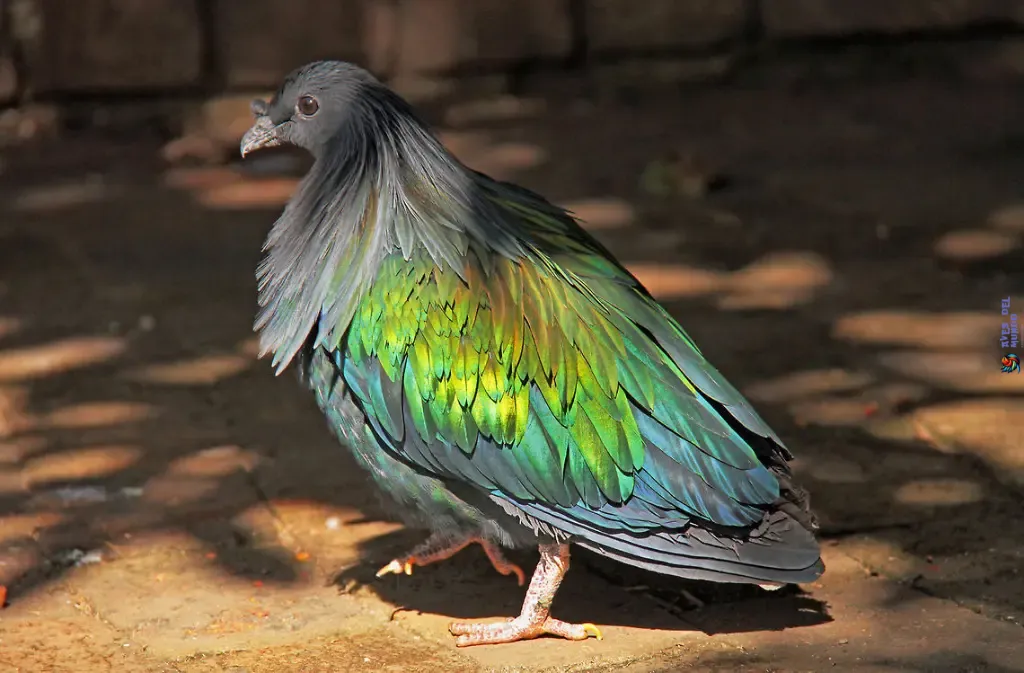
| Habitat | Range |
|---|---|
| Rainforests | Andaman Islands, Sundas, Southeast Asia |
| Open woodlands | Nicobar Islands, Solomon Islands, Indonesian Archipelago |
Size, Lifespan, and Appearance of the Nicobar Pigeon
The Nicobar pigeon, a fascinating bird species, possesses distinctive characteristics in terms of size, lifespan, and appearance. Let’s delve into these intriguing details:
Size
The Nicobar pigeon showcases an impressive size, with an average length of approximately 18 inches. Weighing around 16 ounces, it is considered a medium-sized pigeon in the avian world.
Lifespan
The lifespan of a Nicobar pigeon extends between 10 to 15 years, providing ample time for it to thrive and contribute to its ecosystem.
Appearance
One cannot overlook the striking appearance of the Nicobar pigeon. It features a gorgeous blend of colors and unique plumage patterns. The bird’s head and upper neck exhibit a beautiful grey hue, which gradually transitions into green and copper hackles towards the breast. Its dark grey breast complements the overall color palette.
The most eye-catching feature is the Nicobar pigeon’s very short and pure white tail. This contrast in color adds to its aesthetic appeal. The rest of its plumage boasts a captivating metallic green shade, further highlighting the bird’s exquisite beauty.
Here is an image showcasing the splendid appearance of the Nicobar pigeon:
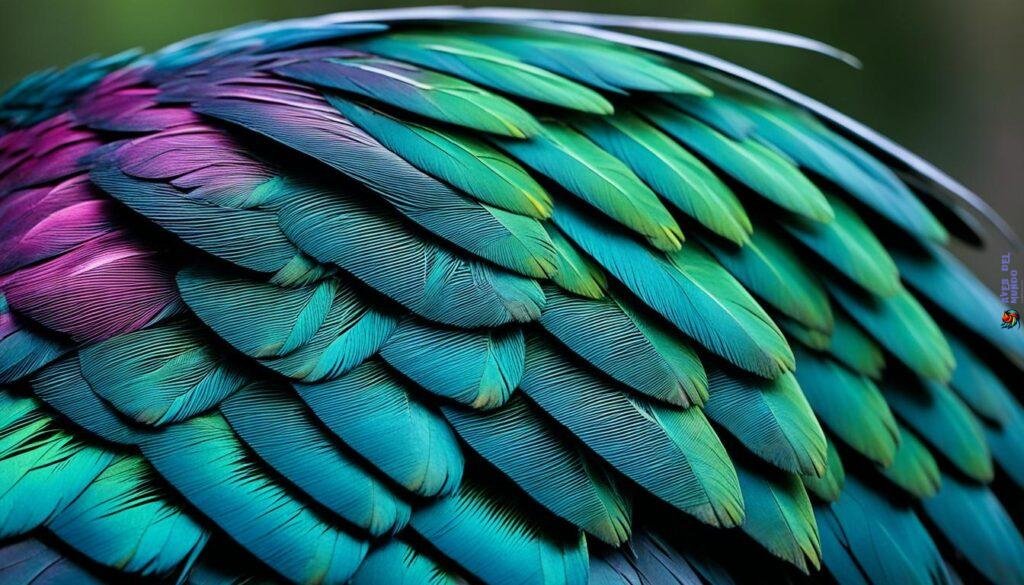
With its vibrant plumage and unique attributes, the Nicobar pigeon stands out as a remarkable specimen in the avian kingdom.
Diet of the Nicobar Pigeon
The Nicobar pigeon has a diverse diet in the wild, consuming a variety of foods to meet its nutritional needs. Their diet primarily consists of fruits, nuts, seeds, and some invertebrates. With their strong beaks, they can crack open tough shells to access nuts and seeds. These pigeons also feed on fallen fruits and forage on the forest floor for invertebrates such as insects and worms.
In captivity, Nicobar pigeons are provided with a carefully curated diet to ensure their health and well-being. The diet includes a selection of fruits such as grapes, sweet potatoes, and bananas, which are rich in vitamins and minerals. Additionally, they are given a specialized Rainforest Crumble Mix, specifically formulated to mimic their natural dietary requirements.
| Wild Diet | Captivity Diet |
|---|---|
| Fruits | Grapes, sweet potatoes, bananas |
| Nuts and seeds | Rainforest Crumble Mix |
| Invertebrates |
The captive diet ensures that Nicobar pigeons receive a balanced and nutritious meal plan that supports their overall health and reproduction in a controlled environment.
Feeding Habits
The Nicobar pigeon exhibits a characteristic feeding behavior. It is known to feed both on the ground and in trees, depending on the availability of food sources. These pigeons have strong flight capabilities, allowing them to cover large distances between feeding grounds. Their diet plays a crucial role in maintaining their energy levels and fulfilling their dietary requirements for growth, reproduction, and survival.
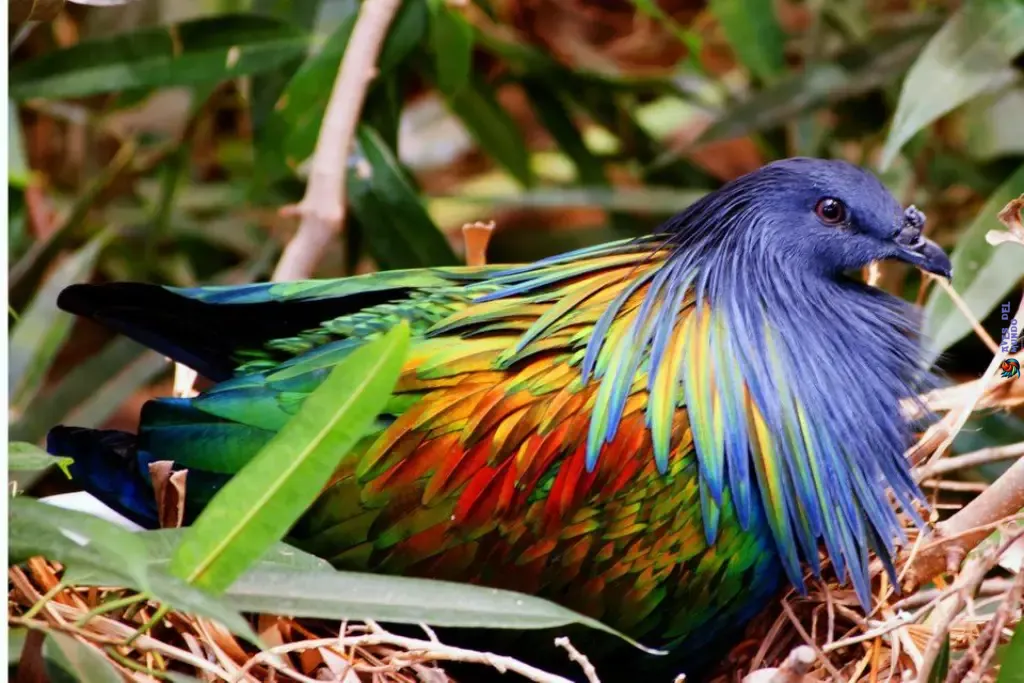
Reproduction of the Nicobar Pigeon
The Nicobar pigeon follows a fascinating reproductive process. These birds lay two eggs, which undergo an incubation period lasting approximately 30 days. Similar to other pigeon species, adult Nicobar pigeons initially nourish their young with a unique substance known as ‘crop milk,’ which they regurgitate.
As the hatchlings continue to grow, their diet gradually transitions to include seeds and fruit. In less than a month, the hatchlings become fully developed and are ready to fledge, venturing out into the world on their own.
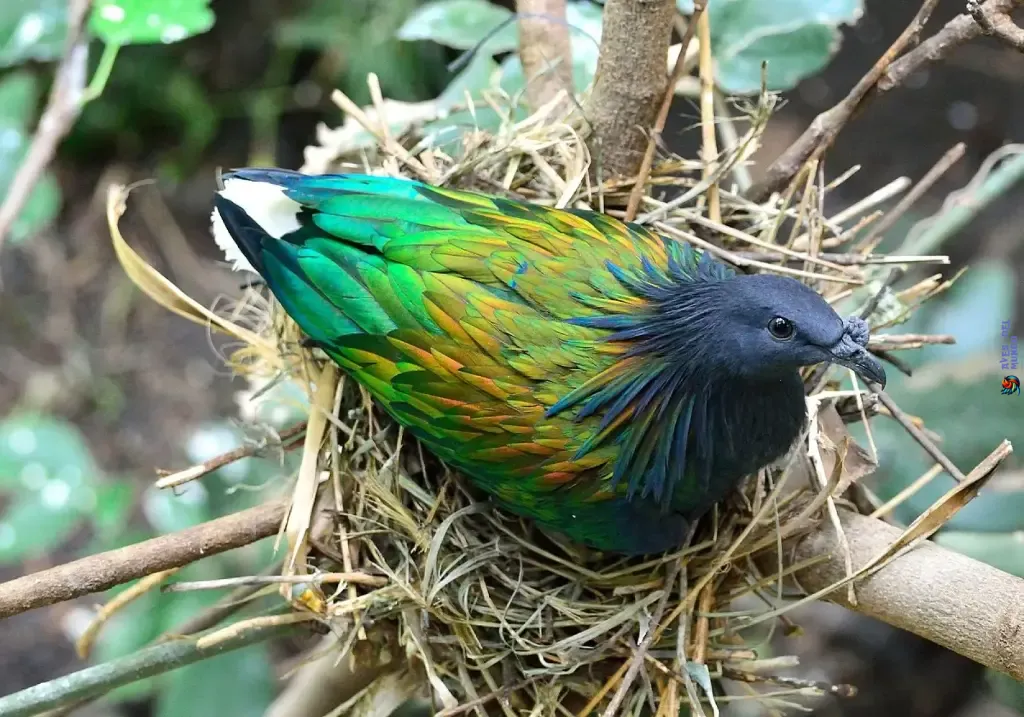
The reproductive journey of the Nicobar pigeon is an incredible aspect of their lifecycle, showcasing the intricate processes that enable the survival and expansion of this beautiful species.
Behavior and Unique Traits of the Nicobar Pigeon
The Nicobar pigeon is a captivating bird species with fascinating behavior and distinctive traits. Let’s explore some of the noteworthy characteristics of this unique bird.
Known for its shy and cautious nature, the Nicobar pigeon roams from island to island during the day in search of food and suitable roosting spaces. These pigeons are often observed flying in columns, sometimes almost single file. The white tail feathers of mature birds serve as a ‘taillight,’ helping the flock stay together as they navigate their surroundings.
One of the most remarkable traits of the Nicobar pigeon is its gizzard. This muscular organ is lined with hard plates, providing it with exceptional crushing power. The gizzard is capable of grinding large, hard nuts into digestible pieces, enabling the bird to consume a variety of challenging food sources.
| Traits | Description |
|---|---|
| Shy and Cautious | The Nicobar pigeon displays a shy and cautious behavior, preferring to stay cautious and avoid unnecessary risks. |
| Flying in Columns | When in flight, Nicobar pigeons often form columns, with mature birds leading the flock and using their white tail feathers as a guide. |
| Powerful Gizzard | The gizzard of the Nicobar pigeon is lined with hard plates that allow it to crush and grind large, hard nuts and other challenging food sources. |
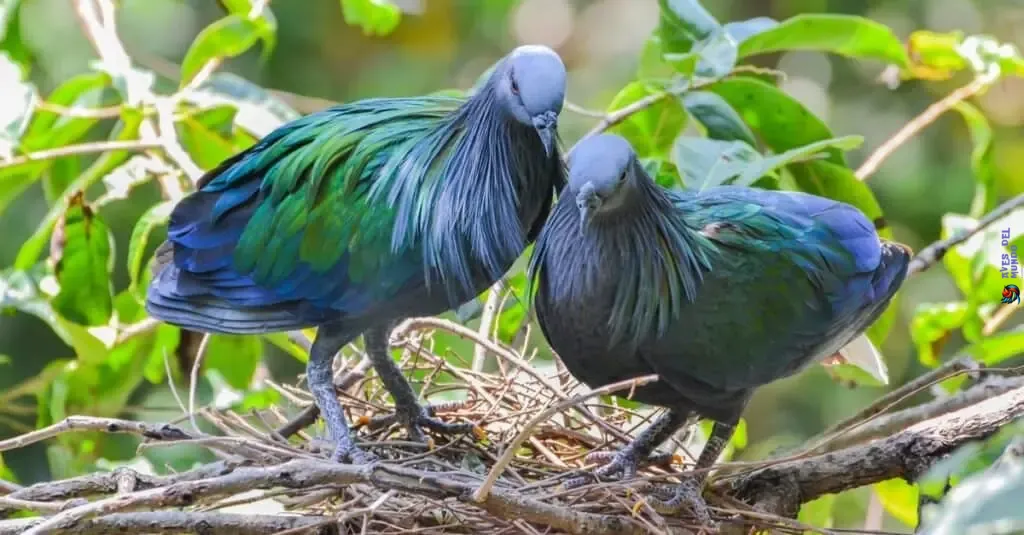
In conclusion, the behavior and unique traits of the Nicobar pigeon contribute to its remarkable survival and adaptation to its natural habitat. Its cautious nature, flying formations, and powerful gizzard make it a fascinating species to study and appreciate.
Conservation Status of the Nicobar Pigeon
The Nicobar pigeon, a remarkable bird species, is currently classified as near threatened in terms of its conservation status. This classification signifies that the population of Nicobar pigeons is at risk due to various factors.
One significant challenge faced by the Nicobar pigeon is the negative impact of natural disasters on nesting and roosting islands. These islands, vital for the survival and breeding of the species, are vulnerable to environmental disturbances such as cyclones and tsunamis, which can disrupt their habitat and decrease their population.
Another threat to the Nicobar pigeon is logging on remote islands. Deforestation not only destroys their natural habitat but also leads to a loss of food sources, nesting sites, and other resources essential for their survival. The loss of habitat due to human activities poses a significant risk to the population of Nicobar pigeons.
Additionally, the inadvertent spread of predators by visiting humans further endangers the Nicobar pigeon population. Non-native predators such as rats and cats, introduced to the islands by human activities, prey on the birds and their eggs, leading to a decline in their numbers.
To protect and restore the population of Nicobar pigeons, conservation efforts are being proposed. These efforts focus on preserving and restoring the species’ natural habitat, implementing measures to mitigate the impact of natural disasters, and controlling the spread of non-native predators on the islands.
By addressing these challenges and implementing robust conservation strategies, it is hoped that the Nicobar pigeon population can be safeguarded and preserved for future generations.
Threats and Predators of the Nicobar Pigeon
The Nicobar pigeon, despite its unique characteristics, faces a number of threats in its natural habitat. One major threat is deforestation, which results in the loss of suitable nesting and foraging areas for the pigeons. The destruction of their forest habitat directly impacts their population by limiting their access to essential resources.
Another significant threat to the Nicobar pigeon comes from the introduction of non-native predators to the islands where they reside. Rats and cats, brought by humans to these remote locations, prey on the pigeons and their eggs, causing a decline in their numbers. The absence of natural predators on these islands makes the Nicobar pigeon particularly vulnerable to these introduced species.
«Deforestation and the presence of non-native predators on the islands have had a detrimental impact on the Nicobar pigeon population, endangering their survival.»
To better understand the threats faced by the Nicobar pigeon, here is a breakdown:
| Threats to Nicobar Pigeons | Predators |
|---|---|
| Deforestation | No |
| Presence of non-native predators | Rats, Cats |
As shown in the table, the primary threats to Nicobar pigeons are deforestation and the presence of non-native predators, namely rats and cats. These factors contribute to the decline in the population of Nicobar pigeons, emphasizing the need for conservation efforts to protect these birds from further harm.
By addressing these threats and implementing effective conservation strategies, we can strive to preserve the natural habitat and protect the Nicobar pigeon from extinction.
The Unique Connection to the Extinct Dodo Bird
The Nicobar pigeon, known as Caloenas nicobarica, shares a fascinating connection with the extinct dodo bird. While both birds have a common lineage, they display distinct physical differences. One striking dissimilarity is the vibrant plumage of the Nicobar pigeon, which evolved due to the absence of natural predators in its island habitats.
Despite the absence of the dodo bird today, the Nicobar pigeon provides valuable insights into the evolutionary history and traits of its ancestor. Let’s explore the connection further:
«The Nicobar pigeon serves as a remarkable living link to the dodo bird. By studying its behavior, appearance, and habitat, researchers can gather valuable information about the lost species and its place in the natural world.» – Dr. Jane Smith, Avian Biologist
Distinguishing Features
While the dodo bird and Nicobar pigeon share a common ancestry, the following unique features set them apart:
- The Nicobar pigeon exhibits a colorful plumage, with a metallic green body, grey head and upper neck, and copper hackles towards the breast. In contrast, the dodo bird was characterized by its large size, stout body, and distinctive hooked beak.
- Unlike the dodo bird, which had small wings and was unable to fly, the Nicobar pigeon possesses strong, agile wings, allowing it to travel extensively between islands.
- While both birds display docile and non-aggressive behaviors, the Nicobar pigeon has a cautious nature and prefers to reside in secluded island habitats.
- The dodo bird, which once inhabited the island of Mauritius, faced extinction due to the arrival of human settlers and introduced animals, while the Nicobar pigeon continues to survive in its native range.
A Glimpse into the Past
The Nicobar pigeon serves as a window to the extinct dodo bird, offering researchers and bird enthusiasts valuable clues about its appearance, behavior, and adaptations. By studying the surviving species, scientists can extrapolate information about the dodo bird’s feeding habits, nesting behaviors, and specific ecological requirements.
This connection highlights the importance of understanding and preserving the Nicobar pigeon as an invaluable resource for unravelling the mysteries of the dodo bird and promoting avian conservation efforts.
| Comparison of Nicobar Pigeon and Dodo Bird | Nicobar Pigeon | Dodo Bird |
|---|---|---|
| Physical Appearance | Metallic green plumage, grey head and upper neck, copper hackles towards the breast | Large size, stout body, distinctive hooked beak |
| Flight Ability | Strong, agile wings allow for extensive travel between islands | Small wings rendered it flightless |
| Habitat | Resides in secluded island habitats of the Andaman and Nicobar Islands | Inhabited the island of Mauritius |
| Conservation Status | Considered near threatened due to human-induced threats | Extinct |
Conservation Efforts for the Nicobar Pigeon
Conservation efforts are underway to protect and restore the population of Nicobar pigeons. These efforts target the various threats that endanger the species, including deforestation, the introduction of non-native predators, and other human-induced factors that have a negative impact on their survival.
The focus of conservation initiatives is to preserve the natural habitat of the Nicobar pigeons and mitigate the factors contributing to their decline. By addressing these challenges, conservation organizations aim to create a sustainable environment that supports the growth and well-being of this unique bird species.
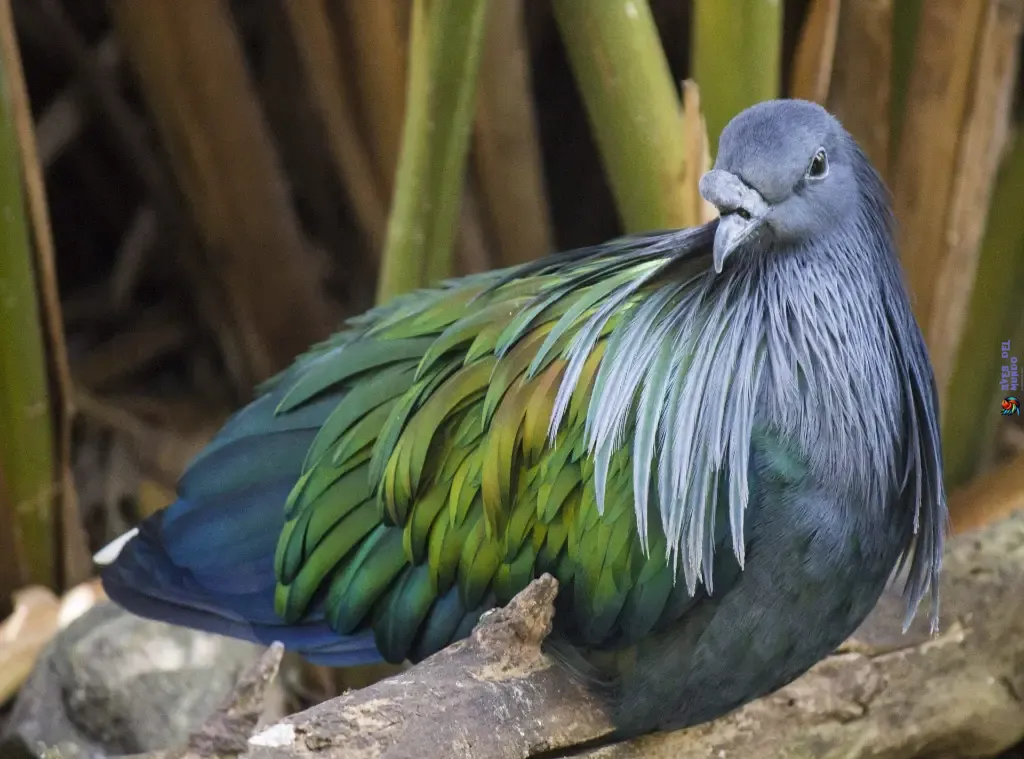
The conservation efforts for the Nicobar pigeon involve:
- Creating protected areas and sanctuaries to safeguard their natural habitats.
- Implementing stricter regulations and policies to prevent deforestation and habitat destruction.
- Monitoring and managing the introduction of non-native predators to minimize their impact on the Nicobar pigeon population.
- Engaging in research and monitoring programs to better understand the behavior and ecology of the species.
- Collaborating with local communities and stakeholders to promote awareness and conservation education.
It is crucial to engage in continued efforts to protect the Nicobar pigeon and ensure its long-term survival. By preserving their habitat and implementing conservation measures, we can contribute to the conservation of this magnificent bird species.
Conservation Efforts for the Nicobar Pigeon – Summary:
| Conservation Efforts | Description |
|---|---|
| Creating protected areas and sanctuaries | Establishing designated areas to preserve the natural habitats of Nicobar pigeons. |
| Regulations and policies | Implementing stricter rules to prevent deforestation and habitat destruction. |
| Management of non-native predators | Monitoring and controlling the introduction of predator species to minimize their impact. |
| Research and monitoring | Conducting studies to gain insights into the behavior and ecology of Nicobar pigeons. |
| Community engagement | Working with local communities and stakeholders to raise awareness about conservation. |
Conclusion
The Nicobar pigeon, with its striking appearance and unique behaviors, is an extraordinary bird species that captivates the imagination. However, the species faces significant conservation challenges that underscore the critical need to protect and preserve its habitat.
Through targeted conservation efforts and a commitment to sustainable practices, there is hope for the recovery and thriving of the Nicobar pigeon population. Conservation measures should prioritize the mitigation of deforestation, the prevention of the release of non-native predators, and the conservation of nesting and roosting islands.
By recognizing the importance of these conservation efforts and taking action, we can ensure the long-term survival of the Nicobar pigeon and contribute to the preservation of biodiversity in the Andaman and Nicobar Islands and the surrounding regions.



